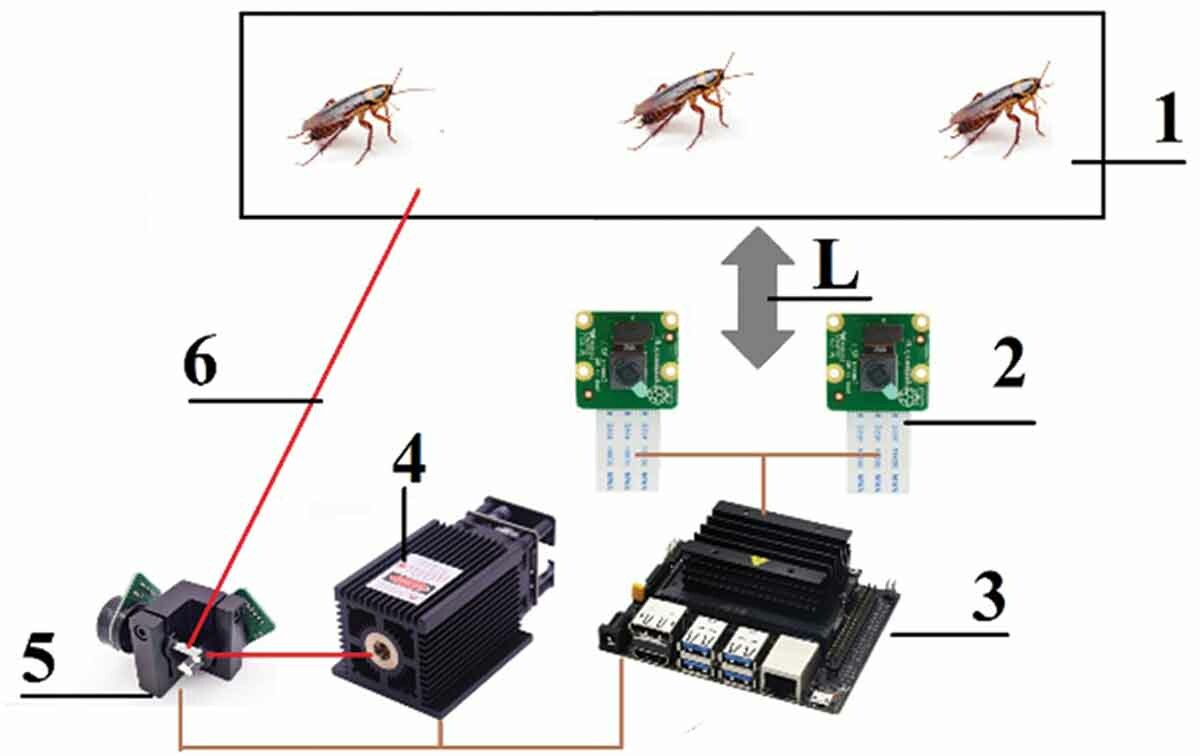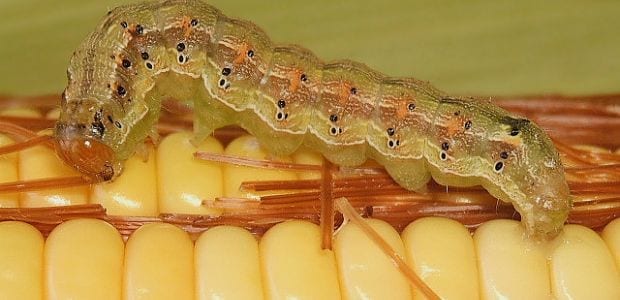
Summary diagram of the laser setup: 1 – transparent box containing cockroaches, 2 – Pi cameras, 3 – Jetson nano, 4 – laser, 5 – galvanometer, 6 – laser beam, L – distance between laser device and target.
Controlling insect pests still relies on the extensive usage of generic and established methods, such as pesticides, which utilise broad spectrum chemicals or toxins persisting in the environment and targeting non-pest insect species.
Therefore, more effective and environmental friendly approaches are needed to counteract these damaging effects. Since a laser can be remotely directed to neutralise undesirable targets, this approach could be highly promising for controlling insect pests in a selective and ecofriendly fashion. In this study, we present a laser system automated by machine vision for neutralising and influencing the behaviour of insect pests. By performing experiments on domiciliary cockroaches, Blattella germanica, we demonstrate that our approach enables the immediate and selective neutralisation of individual insects at a distance up to 1.2 m. We further show the possibility to deter cockroaches by training them not to hide under a dark shelter through aversive heat conditioning with a low power-laser. Parameters of our prototype system can readily be tuned for applications in various situations and on different pest species like mosquitoes, locusts, and caterpillars. The prospect of this study is to pursue the creation of a standalone, safe for the environment, compact, low-cost, and energy-efficient device system for pest control.
Introduction
Pest control is a major issue for the food industry and public health. Current agrochemical practices for controlling harmful insects are generally problematic because they lead to resistance and often impact non-targeted species. This is the case of the massive utilisation of non-specific insecticides for crop protection that largely contributes to pollinator declines (Colin 2020). To overcome these problems, biocontrol solutions have been developed using natural predators or chemical traps releasing molecules involved in the communication of targeted pests. However, even when these practices are possible, not only a detailed knowledge of the biology of species is required but also their impact has to be taken in into consideration prior any efficient implementation. Thus, a more generic approach that can be targeted to specific animal pests without damaging the environment should be developed.
Laser (amplification of light by means of stimulated emission) may provide an alternative approach for the selective neutralisation of unwanted targets, such as animal pests and weeds. For instance, Brown et al. (2021) discussed the possibility of using a laser for birds to protect sweet corn fields. Furthermore, Xiong et al. (2017) tested a robot with a static laser for weeding during strawberry harvesting. However, a major drawback of this approach for large-scale deployment is that it requires specific types of equipments that are costly and complex to implement. Recently, we successfully tested the possibility of using a laser to kill mosquitoes (Rakhmatulin 2021), weeds (Rakhmatulin 2020) and created a simulation program for the destruction of locusts and caterpillars (Rakhmatulin 2021). Despite in these previous studies an economical and energy-efficient laser prototype was developed, we envisioned major health and safety risks that could be triggered by the use of high laser power, such as eye damage and fire ignition, which prevented the large-scale expansion of our prototype. Therefore, further laser theory considerations were needed in order to develop robust and safe biocontrol approaches.
The idea of using a galvanometer (i.e., an electromechanical instrument for measuring electric current) was previously used for directing the laser in other applications. For instance, Hegna et al. (2010) used a laser galvanometer to tilt the beam from a laser range finder along an object of interest to determine its geometric properties and therefore developing a more effective 3-D scanning system. In addition, Huang et al. (2020) considered the magnetic properties of the rotor and concluded that the energy consumption of the motor can be reduced by reducing the total number of changes in the position of the mirrors per second. In this paper, we have tested the efficiency of our improved automated vision driven Laser prototype to with the German cockroach Blattella germanica (Linnaeus 1767), which is one of the major urban pest species worldwide (Lihoreau et al. 2012). These domiciliary cockroaches can live in populations of millions of individuals, potentially spoiling food, household, and electrical appliances (Nasirian 2017), but also being a serious health hazard triggering allergic reactions and the development of asthma. Despite various methods are used to control cockroaches, there is still no perfect solution (Pan 2020). The most efficient approaches so far are mechanical (e.g., sticky traps) and chemicals (insecticidal gels and pastes). These methods have the disadvantage of having a limited catching range and therefore many individuals may not visit the trap areas. In addition, long-term chemical treatments may lead to problematic resistances.
We have improved our previous prototype by using galvanometer mirrors driven by neural networks algorithms to control the laser beam direction to efficiently target moving cockroaches in a controlled environment. This work demonstrates that our prototype is able to neutralise and deter cockroaches efficiently at specific distances depending on the laser power utilised. Thus, our approach (laser-targeted) could offer an effective, ecofriendly, and low-cost alternative to control the number of cockroaches and possibly other insects in different environments (i.e., domestic households, fields).
Methods
We have improved our previous approach (Rakhmatulin 2021) by developing the laser system automated by machine vision for neutralising and deterring moving insect pests. Guidance of the laser by machine vision allows for faster and more selective usage of the laser to locate objects more precisely, therefore decreasing associated risks of off-target laser exposure. In this device, the laser beam is controlled by galvanometer mirrors driven by a Jetson Nano single-board computer which uses deep learning algorithms (neural networks) for detecting moving objects and training.
Original Article: Selective neutralisation and deterring of cockroaches with laser automated by machine vision
More from: Heriot-Watt University | University of Sussex | Paul Sabatier University
The Latest Updates from Bing News
Go deeper with Bing News on:
AI pest control
- SafePest Control: Revolutionising Pest Management with the Launch of Smart Digital Rodent Bait Stations
SafePest Control, a leading provider of innovative pest management solutions, is proud to announce the launch of its latest breakthrough ...
- Do you need a pest control company? Here are 5 signs that you do
From creepy sounds to visible structural damage, these five signs mean it's time to call a professional pest control company.
- ConsumerAffairs recognizes 12 companies for home safety, pest control, flooring and hearing aids in 2024 Buyer's Choice Awards
TULSA, Okla., May 8, 2024 /PRNewswire/ -- ConsumerAffairs , the reviews platform whose content and tools give consumers an advantage when making difficult purchases, has named 12 more companies ...
- Best Pest Control Companies Of 2024
Hiring a professional pest control service to eliminate and control these stubborn creatures is typically the best way to deal with the situation. Whether your home is in the grips of an invasion ...
- ISU researcher presents at White House AI event; team wins grant for AI ag tool
At Iowa State, Ganapathysubramanian said researchers have been working on their approach for about two years with support from two federally funded efforts on campus. Those are AIIRA, the AI Institute ...
Go deeper with Bing News on:
Controlling insect pests
- Business Matters: Jay’s Pest Control handles any animal/insect troubles
Jay Klein owns Jay's Pest Control in Midland, which handles any and all troublesome animals/insects from raccoons to pythons throughout Michigan.
- Advanced Pest Control Systems provides trusted pest control
Advanced Pest Control Systems has been providing trusted and reliable pest control in Cape Girardeau County for decades. Locals Gary and Penny Schuessler currently own the business founded by Gary's ...
- The Pest Control Mistake That's Driving Hummingbirds Away From Your Yard
With their shiny feathers, their itty-bitty size, and their ever-moving wings — hummingbirds are truly unique in every way and add an enjoyable element to your flower garden. If you love seeing these ...
- Atlas Termite & Pest Control Offering Free Termite Inspections in Norman
Atlas Termite & Pest Control in Norman, OK, launches free termite inspections for residents and businesses. With spring's arrival, the risk of termite infestations increases. The initiative aims to ...
- SafePest Control: Revolutionising Pest Management with the Launch of Smart Digital Rodent Bait Stations
SafePest Control, a leading provider of innovative pest management solutions, is proud to announce the launch of its latest breakthrough ...
insect pests” num_posts=”5″ blurb_length=”0″ show_thumb=”left”]










